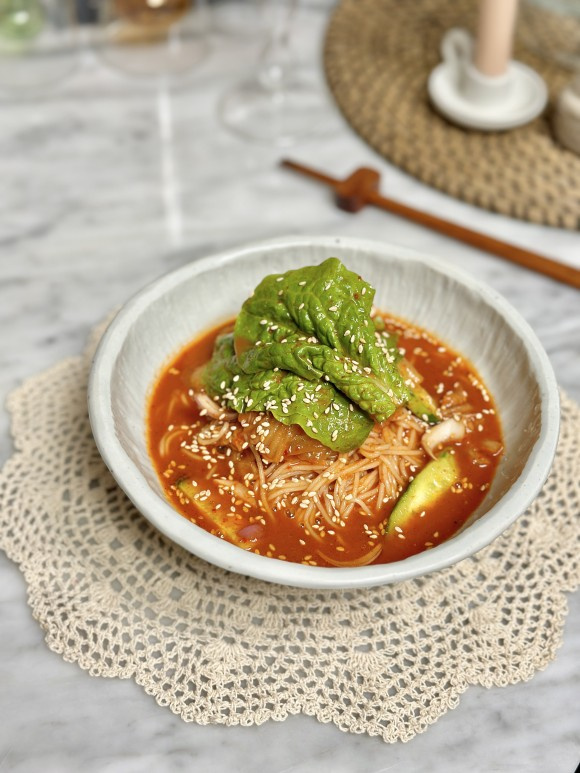Manghyang Bibim Guksu (Spicy Mixed Noodles)
Enjoy the Flavorful Manghyang Bibim Guksu at Home with this Golden Recipe!

When you’re contemplating what noodle dish to make, the image of Manghyang Bibim Guksu with its rich, brothy sauce likely comes to mind! If you have cucumbers and lettuce in your fridge, you can create this delightful dish without needing many extra ingredients. It offers a unique charm compared to regular bibim guksu, with its moist broth and harmonious flavors. Let me guide you through this detailed Manghyang Bibim Guksu recipe.
Main Ingredients- 200g Somyeon noodles (thin wheat noodles)
- 100g Aged kimchi
- 6 Lettuce leaves
- 1/2 Onion
- 1 Cucumber
Seasoning Ingredients- 1 Tbsp minced garlic
- 4 Tbsp gochugaru (Korean chili flakes)
- 3 Tbsp gochujang (Korean chili paste)
- 2 Tbsp soy sauce
- 2 Tbsp vinegar
- 3 Tbsp allulose (or sugar)
- 1 Tbsp sesame oil
- 1 cup dongchimi brine (approx. 200ml)
- 1 Tbsp sesame seeds
- 1 Tbsp minced garlic
- 4 Tbsp gochugaru (Korean chili flakes)
- 3 Tbsp gochujang (Korean chili paste)
- 2 Tbsp soy sauce
- 2 Tbsp vinegar
- 3 Tbsp allulose (or sugar)
- 1 Tbsp sesame oil
- 1 cup dongchimi brine (approx. 200ml)
- 1 Tbsp sesame seeds
Cooking Instructions
Step 1
First, thoroughly wash and prepare all the ingredients for the bibim guksu. Ensure the aged kimchi is ready to be well mixed with the sauce.

Step 2
Slice the onion into strips about 7-8mm thick. If you don’t have an onion, using shallots will add a wonderful flavor.

Step 3
Lightly peel the cucumber (a vegetable peeler works well) and cut it in half lengthwise, then slice it into half-moon shapes. Avoid slicing too thinly to maintain a crisp texture. You can also cut them into your preferred shape.

Step 4
Tear or cut the lettuce leaves into bite-sized pieces. If your lettuce leaves are small, you can leave them whole. For larger leaves, cut them into 2-3 pieces.

Step 5
Now, let’s make the flavorful sauce that defines this bibim guksu. In a large bowl, combine 1 Tbsp minced garlic, 4 Tbsp gochugaru, 3 Tbsp gochujang, 2 Tbsp soy sauce, 2 Tbsp vinegar, 1 Tbsp sesame oil, and 3 Tbsp allulose (or sugar). Mix everything well. If your aged kimchi is quite sour, add a little more allulose (or sugar) to balance the flavors.

Step 6
Add 100g of the prepared aged kimchi to the sauce bowl. While you can mix the sauce first and then add the kimchi, combining them all at once can save time and effort.

Step 7
Here’s a special element of this recipe – the dongchimi brine! While the pictured dongchimi was homemade, you can achieve a delicious result using store-bought dongchimi (radish kimchi) cold broth, often found for cold noodles. Use only the brine, discarding the solids.

Step 8
Pour 1 cup (approximately 200ml) of the flavorful dongchimi brine into the sauce bowl. This brine will add a refreshing, moist quality to your bibim guksu.

Step 9
Stir all the sauce ingredients and the dongchimi brine thoroughly until well combined. Your delicious, well-seasoned sauce is now ready.

Step 10
It’s time to cook the noodles. Refer to the cooking time indicated on the noodle package and cook them accordingly. Since the cooking time is short, you can efficiently prepare other ingredients or mix the sauce while the noodles are boiling.

Step 11
Once the noodles are cooked, quickly drain them and rinse thoroughly under cold running water. This step is crucial for removing excess starch, ensuring the noodles have a chewy and delightful texture.

Step 12
Add the drained noodles to the bowl with the prepared sauce. Then, add the sliced cucumber, onion, and sesame seeds. Gently toss everything together until the noodles and vegetables are evenly coated with the sauce.

Step 13
Transfer the well-mixed noodles and vegetables to a serving bowl. For a beautiful presentation, lightly dip the lettuce leaves in the sauce before placing them on top as a garnish.

Step 14
Finally, sprinkle a bit more sesame seeds on top for decoration. Behold, your appetizing Manghyang Bibim Guksu is ready! As they say, good presentation leads to good taste. This dish offers visual appeal and a deep, refreshing flavor. Though the recipe is simple, its excellent taste makes it a dish you’ll want to make often. Save this Manghyang Bibim Guksu recipe for special occasions or whenever you crave a delicious noodle dish!




